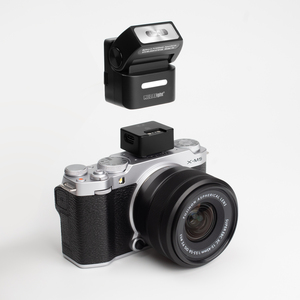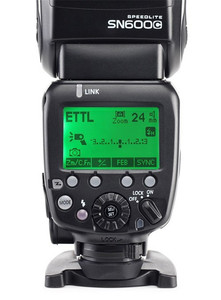
All categories
Featured selections
Trade Assurance
Buyer Central
Help Center
Get the app
Become a supplier

(1028 products available)











































The camera flash gun is a crucial piece of camera equipment that helps to illuminate subjects in poorly lit areas. The different types of camera flashes available are as follows:
Increased Light Output:
Compared to built-in camera flashes, external camera flash guns provide much greater light output. They have higher Guide Numbers (GNs), which measure a flash's range and power capacity. This allows for better illumination when photographing further away subjects or in larger spaces.
Highlight Control:
Flash guns allow for more precise control over highlighting compared to built-in flashes. This is made possible by features like adjustable power levels, which enable the photographer to tailor each shot's lighting to their specific needs.
Multiple Sync Options:
Flash guns give photographers a choice between various syncing methods, which synchronize the flash with the camera's shutter speed. These include standard, high-speed (for use with fast shutter speeds), and rear curtain (where the flash fires just before the movement ends). These choices provide flexibility for capturing different types of shots.
Zoom Head:
Many high-quality flash guns come equipped with a zoom head feature. This feature adjusts the flash's coverage to match that of the lens in use, ensuring accurate lighting whether one is using a wide-angle or telephoto lens.
Wireless Triggering:
Flash guns can be wirelessly triggered using compatible receivers or transceivers placed on the same frequency channel as the transmitter. This allows for off-camera flash photography, where multiple gun flashes or a single gun flash can be positioned away from the camera to create more dynamic lighting setups for various shots.
Slave/Multimode:
Some gun flashes have a slave or multi-mode feature, which allows them to be triggered by a master flash or the camera's built-in flash. This enables the use of multiple light sources for more complex lighting setups.
Stroboscopic/Repeater Mode:
Gun flashes may have a stroboscopic or repeater mode that produces a series of low-intensity flashes. This feature is useful for creating special effects or for freeze-frame photography, where multiple images are captured in a single frame.
Lighting Modification Accessories:
Flash guns also have a range of modification accessories, such as diffusers, reflectors, and snoots. These accessories allow the photographer to shape and control the flash better, providing more creative lighting solutions that can be tailored to suit a wide variety of shooting situations.
Camera flash guns are versatile accessories that can elevate a photographer's work in various applications. Here are some common usage scenarios:
Portrait Photography
In portrait photography, a camera flash gun helps freeze the subject mid-action and provide enough illumination to shape the subject's features. This is especially useful when photographing diverse skin tones since the flash can be modified with diffusion or bounce techniques to be softer and more flattering.
Event Coverage
A well-known use of flash guns occurs when photographers cover events like weddings, parties, or corporate functions. Here, the flash allows them to capture crucial moments in low-light settings while also controlling shadows and highlights for optimal exposure. The on-camera design of the flash gun makes it easy for shooters to move around and photograph various activities rapidly.
Sports and Action Photography
Flash guns are indispensable for shooting fast-paced sports and action scenes. These photographers depend on high-speed sync flash guns to arrest movements and create sharp images, even when the natural light is inadequate. Furthermore, the flash enhances freeze-frame capabilities to show details like facial expressions or body postures that would otherwise be difficult to see.
Macro & Close-up Photography
Photographing small objects such as bugs or flowers leaves little room for manipulating light. In these situations, an external flash gun perfectly enhances the level of detail and sharpness in the final image. With precise control over lighting directions, intensities, and softening techniques, photographers can explore diverse textures and colors in the macro realm.
Product & Studio Photography
Studio shooters rely heavily on flash guns to achieve well-balanced and creatively lit images of products, models, or still life setups. Multiple off-camera flash units are often used in conjunction with light modifiers (suchonsmallsnoots or grids) to create intricate lighting patterns and highlight specific features or textures.
portrait and Event Coverage
Flash guns have revolutionized portrait and event photography, enabling photographers to master light control even in challenging conditions. With their compact size, portability, and power, these gun-style flashes have become essential tools for both amateur and professional shooters seeking to create stunning, well-lit images in a variety of situations.
Camera flash guns are important for taking well-lit pictures. One aid will be to think about the type of camera equipment and the gun. Some camera flash guns work with specific brands, so it is important to pick one that will work well with the kind of camera and lens. Be sure to check which ones work with digital single-lens reflex (DSLR) cameras, mirrorless cameras, and point-and-shoots.
Another important thing is to look at how high the flash gun can reach (guide number). The guide number shows how bright the flash will be. A higher guide number means the flash can reach farther or be brighter. It will be good to pick a flash gun with a guide number that is right for the pictures to be taken. Consider if a manual or automatic flash is needed. Flash guns with manual flash, give more control over the settings like flash power and zoom. Manual means the amount of light and time has to be set by hand. Automatic flash guns do everything by itself. It is easier to use the automatic one because it thinks for itself. Whether flash guns also work as wireless triggers to use off-camera flashes is another thing to consider. Off-camera means that the flash gun can be taken anywhere and not just next to the camera. This would help create more light options. Lastly, consider the price and any extra features like built-in filters, touchscreen displays, or weather sealing. Comparing different flash gun reviews will help to see which one fits needs and budget.
Q1: What type of camera flash is best?
A1: The most suitable type of camera flash highly depends on the specific need. However, an external flash is generally more powerful and versatile than an on-camera flash.
Q2: Do I need a flash for my camera?
A2: While it's possible to take pictures without a flash, having one can be beneficial. A flash provides extra light, filling in shadows for portraits and close-up shots, allowing for better-detailed pictures in low-light conditions.
Q3: Can I use a professional camera without a battery?
A3: A functioning camera is impossible without a battery or any power source. While most modern cameras use rechargeable lithium-ion batteries, alkaline AA batteries are also used in some models. To use a camera without a battery, photographers may use AC adapters to connect the camera to a power outlet for continuous operation, especially during studio shoots. However, this setup is not portable and limits the camera's mobility.
Q4: What is the disadvantage of a high-speed sync flash?
A4: The high-speed sync flash consumes a lot of energy from the flash capacitor. This rapid depletion of energy can reduce the maximum output power of the flash and create potentially annoying side effects in terms of inconsistent lighting.